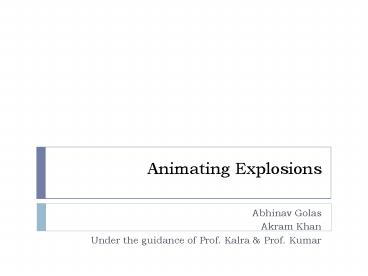Animating Explosions PowerPoint PPT Presentation
Title: Animating Explosions
1
Animating Explosions
- Abhinav Golas
- Akram Khan
- Under the guidance of Prof. Kalra Prof. Kumar
2
Outline
- The problem
- How weve split the problem
- Current progress
- Some comparison
3
The problem
- Animating explosions Navier Stokes
- Modeling the pressure wave
- Issues
- Large quantities
- Large spatial temporal derivatives
- Inherent shocks (speed of sound)
- Large bulk transfer
4
How weve split the problem
- Abhinav
- Navier Stokes modeling
- Focus on seeing impact of viscosity on simulation
in different media - Models for different solver components applying
known methods for incompressible flows to problem
- Akram
- Euler equation modeling inviscid Navier Stokes
- Mostly first derivatives scope for linear
algebra based solvers - Focus will be on modeling as sparse linear systems
5
Current Progress
- Our implementation
- Ready
- Some methods for larger timestep simulation ready
- Original paper implementation (Animating
Explosions Yngve et al, SIGGRAPH 2000) - 2D version ready some parameter tuning required
- Rendering
- Renderman based particle systems renderer
- Uses order of 100000 particles
6
Some comparison
- Original implementation
- 0.1 ms timestep for simple blast case
- Our implementation
- 1 ms timestep for simple blast case using
multistep advection - 5 ms timestep for same case also done.
7
Modifications made
- Staggered grid (vs. centralized grid)
- Better accuracy of spatial derivatives
- Semi-lagrangian based multi-step advecton(vs.
donor acceptor method) - Much more stable guarantee of outputltinput
(but slight dissipation) - Allows for larger timesteps
- Step 1ms 5ms
- Frame at 15ms
8
Future work
- Complete comparison with earlier implementation
- Improve methods to allow larger timesteps
- Improve rendering
- Experiment with ENO methods (CFD)
- Develop solid interaction and fracturing models
9
Thanks
PowerShow.com is a leading presentation sharing website. It has millions of presentations already uploaded and available with 1,000s more being uploaded by its users every day. Whatever your area of interest, here you’ll be able to find and view presentations you’ll love and possibly download. And, best of all, it is completely free and easy to use.
You might even have a presentation you’d like to share with others. If so, just upload it to PowerShow.com. We’ll convert it to an HTML5 slideshow that includes all the media types you’ve already added: audio, video, music, pictures, animations and transition effects. Then you can share it with your target audience as well as PowerShow.com’s millions of monthly visitors. And, again, it’s all free.
About the Developers
PowerShow.com is brought to you by CrystalGraphics, the award-winning developer and market-leading publisher of rich-media enhancement products for presentations. Our product offerings include millions of PowerPoint templates, diagrams, animated 3D characters and more.

